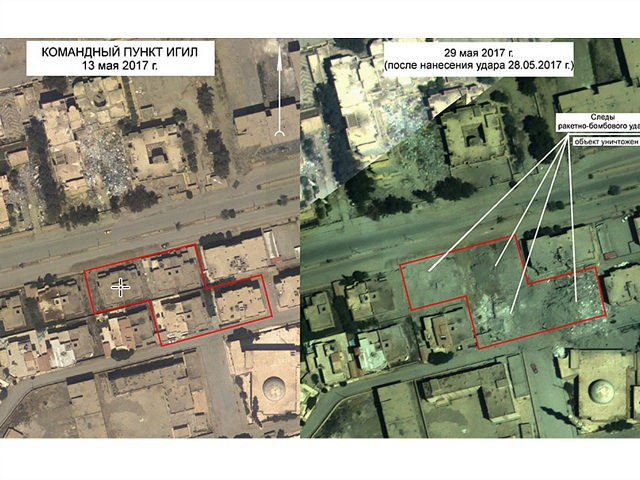Russia’s Defense Ministry released satellite photos over the weekend purportedly showing the ruins of the Islamic State command bunker where ISIS “caliph” Abu Bakr al-Baghdadi was allegedly killed by an airstrike, along with dozens of ISIS leaders.
According to Russia, the bunker was targeted while Baghdadi and about 30 ISIS leaders gathered to discuss plans for pulling out of Raqqa, the Islamic State’s besieged capital in Syria.
The Russian photos show a cluster of buildings on the outskirts of Raqqa that does seem to have been pulverized by airstrikes, with little more than scattered debris left over from buildings that were in decent shape a month ago.
The Russian airstrike took place on the night of May 28th. The UK Daily Mail notes that was only about a week after the Syrian military claimed it took Baghdadi out with an airstrike on an entirely different location, a claim preceded by dozens of other reports that the ISIS leader had been killed or severely injured.
NBC News cites analysts who believe it would have been uncharacteristically rash and risky for Baghdadi to hold a meeting in Raqqa, with Russian, Syrian, and U.S. airstrikes a constant danger. Ayman Mohyeldin of NBC News called the ISIS leader a “tactical mastermind.”
The Associated Press notes that even the triumphant Russians have admitted they are still working to verify the Baghdadi kill. “I don’t have 100 percent confirmation of the information,” Foreign Minister Sergey Lavrov said.
The AP further notes Baghdadi’s last known audio message was released on November 3rd, so it is difficult to tell if he suddenly “went dark.” ISIS released an audio message from a spokesman on Monday, calling on supporters to carry out more Ramadan attacks in the United States and Europe, but it did not mention Baghdadi.
The last confirmed visual sighting of Baghdadi was his proclamation of the caliphate in Mosul, Iraq, three years ago. According to the Jordan Times, Baghdadi, who has been nicknamed “The Ghost,” probably left Mosul shortly afterward and moved through the Syria-Iraq border region, keeping his profile low.
An interesting wrinkle presented by the Associated Press is that while ISIS might be able to continue functioning at a strategic and administrative level without Baghdadi, he would be very difficult to replace as “caliph” of the Islamic State because the terror group’s mythology reserves that position for descendants of Mohammed’s Quraish tribe. The current second-in-command of ISIS, Ayad Abdul-Rahman al-Obeidi, does not meet this criterion.

COMMENTS
Please let us know if you're having issues with commenting.